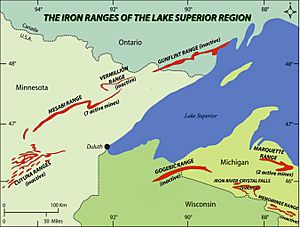Vermilion Range (Minnesota) facts for kids
The Vermilion Range is a special area in northern Minnesota, located between the towns of Tower and Ely. It's famous for having lots of iron ore, which is a rock that contains iron metal. The Vermilion Range is one of three main "Iron Ranges" in Minnesota, along with the Mesabi and Cuyuna Ranges. These areas were formed a very long time ago.
While the Mesabi Range had iron ore close to the surface, making it easy to dig up in big open pits, the iron in the Vermilion Range was much deeper underground. This meant miners had to dig deep tunnels to reach it. For example, the Soudan mine went almost half a mile underground! Miners had to use explosives to blast through the very old, hard rock called taconite to get to the ore.
Contents
What is the Vermilion Range?
The Vermilion Range is a long strip of land known for its valuable iron deposits. It stretches across the northeastern part of Minnesota. This region played a huge role in providing the iron needed to build cities and industries across the United States.
How Was the Iron Formed?
The iron ore in the Vermilion Range is part of something called a "banded iron formation." Imagine layers of different rocks stacked together. This formation is made up of layers of chert (a hard, fine-grained rock), magnetite, and hematite. Magnetite and hematite are both types of iron ore.
Deep Mines and Valuable Ore
Eleven different mines operated in the Vermilion Range over the years, with five of them located near the town of Ely. The "Ely Trough" was a folded section of rock that produced a huge amount of iron ore – about 70 million metric tons! Mines like Chandler, Pioneer, Zenith, Sibley, and Savoy were all part of this area.
The biggest mine in the range was the Soudan mine. It closed in 1962, and the last mine in the Ely area stopped operating in 1964. Even though it was very hard work to dig so deep, the iron ore from the Soudan mine was worth the effort. The hematite ore found there was incredibly pure. It was so pure that two pieces could even be welded together! The surrounding rock, called taconite, also contained iron, but in much smaller amounts.
New Ways to Get Iron
Over time, new and more efficient ways to make steel were discovered. These new methods meant that the very high-quality ore from deep mines like Soudan was no longer needed as much. It was simply too expensive to dig up compared to other options.
The special Soudan hematite, sometimes called "Vermilion Lump," was used in older "open hearth furnaces." Its heaviness helped it sink through the melted waste material (slag) to mix with the molten iron. But when newer "blast furnaces" became common, this expensive ore wasn't necessary anymore.
Instead, new ways were developed to get iron from the lower-grade taconite rock. This was done using "open-pit mining," which is much cheaper because you dig from the surface instead of deep underground. Once this new method proved successful, Minnesota's iron industry shifted. It began to focus mainly on the Mesabi Range, where taconite was much easier to reach and mine.


